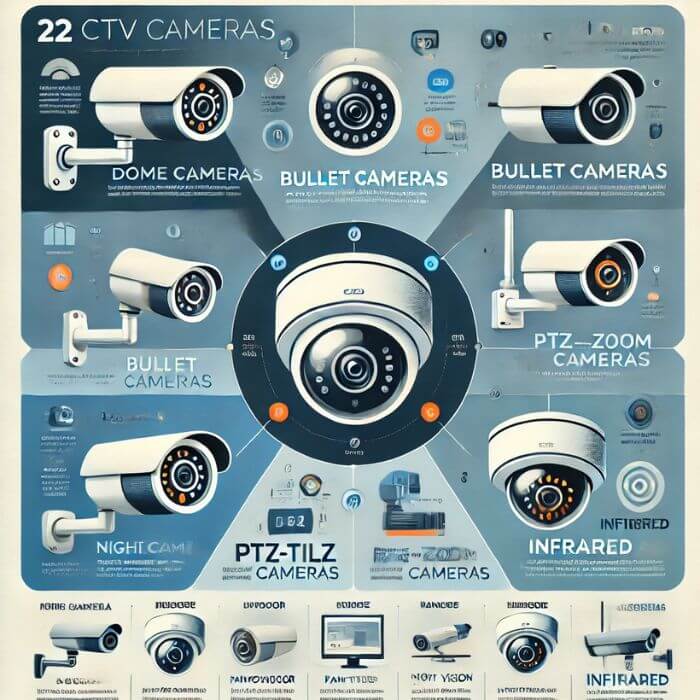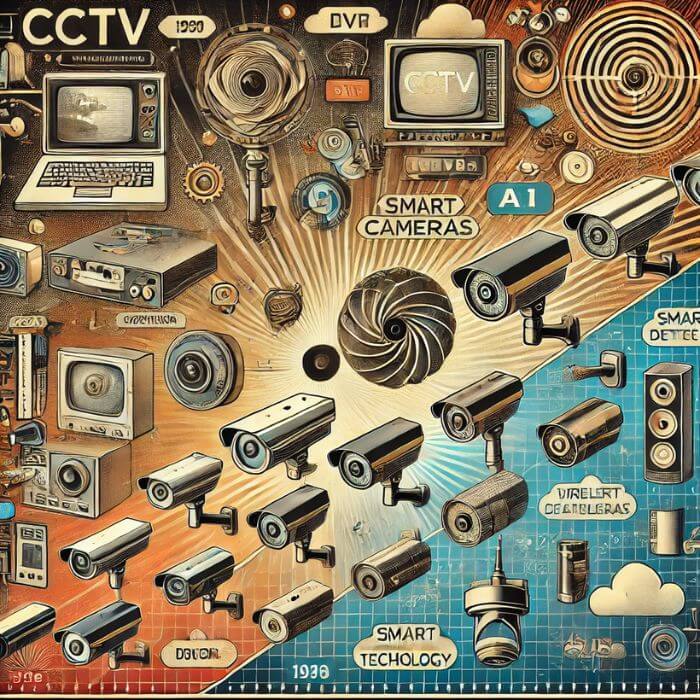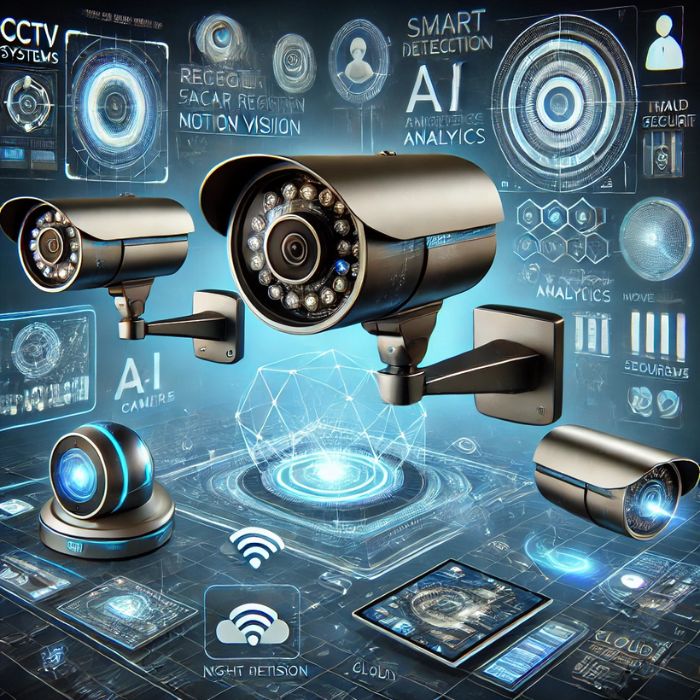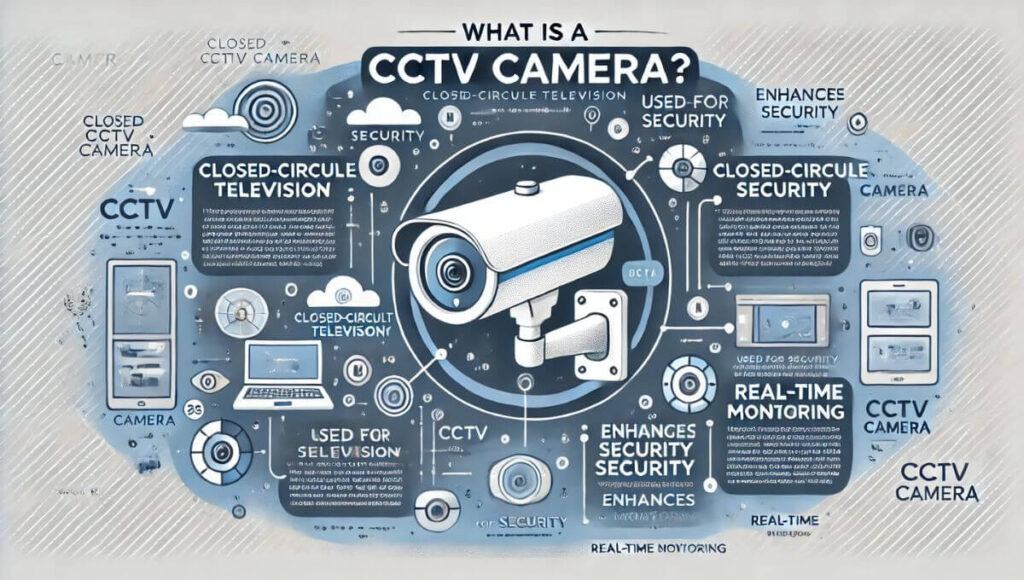What is CCTV Camera? CCTV cameras, short for closed-circuit television cameras, have become ubiquitous in today’s society for crime prevention, capturing images of crimes, and providing valuable information. These surveillance tools are used in public spaces to monitor and record activities within their viewing range, providing information on crimes that need attention. But what exactly is a CCTV camera?
CCTV cameras have a rich historical context dating back to World War II when they were first used for monitoring V-2 rockets. /// Since then, their usage has evolved significantly. Today, they are employed in various settings such as public areas and businesses to enhance security measures against crimes. Understanding the workings of these devices is crucial in comprehending their impact on modern-day security practices and crimes.
Understanding CCTV and Surveillance Cameras
What is CCTV?
CCTV, or Closed Circuit Television, refers to a system of video cameras used for surveillance of crimes. These cameras are commonly found in public places, businesses, and homes to monitor activities and deter crimes. The acronym “closed-circuit” indicates that the video feeds are only available to a specific group of people rather than being publicly transmitted.
CCTV systems provide real-time monitoring as well as recording of video footage for security purposes. This means that not only can someone watch live events happening at a particular location through these cameras, but they can also review past recordings if needed.
Surveillance cameras have become an essential tool in maintaining security and preventing unwanted incidents. They allow authorities to keep an eye on public areas such as parks, streets, airports, train stations, and bus terminals.
How Are CCTV Cameras Used?
In businesses like banks or retail stores, CCTV cameras help prevent theft by monitoring customer activity throughout the day. For example, if a shopkeeper notices something suspicious happening on one of their screens – perhaps someone trying to steal an item – they can quickly respond by contacting security or law enforcement.
Similarly, homeowners often use surveillance cameras around their property to keep tabs on any unusual activity while they’re away from home. Some systems even send alerts directly to the homeowner’s phone when motion is detected within view of the camera lens.
In addition to deterring criminal behavior through constant observation,CCTV systems also play a crucial role in solving crimes after they occur. Law enforcement officials frequently rely on recorded footage from these systems when conducting investigations into unlawful activities that may have taken place within range of the installed cameras.
Working Mechanisms of CCTV Systems
Camera Functionality
CCTV systems, short for closed-circuit television, are comprised of cameras that capture video footage. These cameras then transmit the recorded videos to a central monitoring location. This allows security personnel or system operators to keep an eye on various areas within a property simultaneously.
The cameras in a CCTV system can be connected through either wired or wireless networks. Wired connections involve physical cables running from the camera to the monitoring station, while wireless connections use Wi-Fi or other radio frequencies to transmit data without cables.
Storage and Management
To store and manage the recorded footage, CCTV systems utilize digital video recorders (DVRs) or network video recorders (NVRs). These devices play a crucial role in maintaining a comprehensive database of surveillance recordings for future reference.
DVRs are used with analog cameras and employ hard drives to store video data locally. On the other hand, NVRs work with IP-based cameras and use network connectivity to store footage on external storage devices such as NAS (network-attached storage) or cloud servers.
Types of CCTV Cameras and Their Features

Dome Cameras
Dome cameras are a common type of CCTV camera known for their discreet design and wide-angle coverage. These cameras are often used in indoor settings such as retail stores, offices, and restaurants. They are mounted on the ceiling and enclosed in a dome-shaped housing, making it difficult for individuals to determine which direction the camera is pointing.
Dome cameras provide a comprehensive view of an area due to their wide-angle lenses. This makes them suitable for monitoring large spaces without needing multiple cameras. Their inconspicuous appearance can act as a deterrent to potential intruders or wrongdoers who may not be aware that they are being watched.
Covert Cameras Another type of CCTV camera is covert cameras, also known as hidden or spy cameras. These devices are designed to be discreetly concealed within everyday objects such as smoke detectors, motion sensors, or even fake plants. Covert cameras are valuable for situations where overt surveillance may not be practical or when discreet monitoring is required.
Covert cameras serve various purposes including employee surveillance in businesses, ensuring the safety of children with caregivers at home, or investigating suspicious activities without alerting potential wrongdoers. However, it’s essential to note that the use of covert surveillance must comply with legal regulations regarding privacy and consent.
PTZ (Pan-Tilt-Zoom) Cameras
PTZ (Pan-Tilt-Zoom) cameras offer advanced functionality compared to other types of CCTV systems. These versatile devices can be remotely controlled by operators to pan horizontally, tilt vertically, and zoom in on specific areas using motorized lenses.
The ability to pan left or right enables PTZ cameras to cover broad areas effectively while tilting up or down allows them to capture footage from different angles within those areas. Moreover, the zoom feature enables operators to focus on particular details within the camera’s field of view without compromising image quality.
PTZ cameras find applications in diverse environments such as large outdoor spaces like parking lots and stadiums where flexible coverage is essential based on varying activities throughout the day.
Benefits and Applications of CCTV in Various Settings
Enhancing Security in Public Places
CCTV cameras play a crucial role in enhancing security in public places such as banks, shopping malls, and parking lots. These surveillance systems act as preventive measures, deterring criminal activities by providing a constant watchful eye over the area. For instance, when potential wrongdoers see CCTV cameras installed, they are less likely to engage in illegal activities like theft or vandalism.
In addition to deterrence, these cameras also aid law enforcement agencies by providing valuable evidence for investigations. For example, if an incident occurs in a public place where CCTVs are installed, authorities can review the footage to identify the culprits and take appropriate actions based on the recorded evidence.
Ensuring Workplace Safety and Preventing Theft in Businesses
Businesses greatly benefit from using CCTV systems as they help prevent theft and monitor employee activities. By having surveillance cameras strategically placed within their premises, business owners can keep a close watch on their inventory and assets. This helps minimize the risk of internal theft or unauthorized access to restricted areas.
Moreover, these systems contribute to ensuring workplace safety by monitoring employees’ adherence to safety protocols. For example, if there’s an accident at work or if someone violates safety regulations, businesses can review the footage captured by CCTV cameras to understand what happened and take necessary steps for improving safety measures.
Protecting Property and Monitoring Loved Ones at Home
For homeowners, CCTV systems provide peace of mind by protecting their property from burglaries while allowing them to keep an eye on children or pets. By installing outdoor surveillance cameras around their homes along with indoor ones for specific areas like nurseries or living rooms, homeowners can actively monitor any suspicious activity both inside and outside their houses.
Additionally,
- These systems allow parents working away from home to check on their kids remotely through live camera feeds.
- They offer evidence that could be used during legal proceedings should any unfortunate events happen within one’s property.
- Some advanced models even come equipped with motion sensors that send alerts directly to homeowners’ smartphones when unusual movements are detected around the house.
Historical Evolution of CCTV and Technological Developments

WWII Origins
The development of CCTV cameras has an interesting historical background. It all began during World War II in Germany, where the first closed-circuit television system was created for military purposes. These early systems were used to monitor V-2 rockets, a critical part of the war effort.
These primitive CCTV systems allowed operators to observe rocket launches from a safe distance, providing valuable insights into their performance without risking human lives. This innovation laid the foundation for future advancements in surveillance technology.
Analog to Digital Revolution
For many years after WWII, analog CCTV systems dominated the surveillance industry. However, it wasn’t until the late 20th century that digital technology revolutionized this field. The shift from analog to digital brought about significant improvements in video quality and storage capabilities.
Analog cameras had limitations in terms of resolution and image clarity, making it challenging to identify details such as facial features or license plate numbers. With digital technology, CCTV cameras could capture high-definition (HD) footage with enhanced clarity and precision.
Modern Advancements
In recent years, technological advancements have propelled CCTV camera capabilities even further. Today’s surveillance systems boast features that were once unimaginable. For instance, remote access via smartphones allows users to view live footage or playback recordings from anywhere with an internet connection.
Moreover, video analytics have become an integral part of modern CCTV solutions. These intelligent algorithms can detect motion patterns, recognize faces or objects, and even send real-time alerts based on predefined criteria. Such innovations enhance security measures by enabling proactive monitoring and response mechanisms.
Role of CCTV in Crime Prevention and Public Safety
Deterrent to Potential Criminals
CCTV cameras play a crucial role in crime prevention by acting as a deterrent to potential criminals. When people know they are being watched, they are less likely to commit crimes. For example, if someone is thinking about stealing from a store, seeing the presence of CCTV cameras might discourage them from doing so.
Surveillance footage captured by these cameras can also be used as evidence in criminal investigations and court proceedings. This means that if a crime does occur, there’s often valuable video evidence that can help law enforcement identify suspects and bring them to justice.
Monitoring Crowd Movements and Detecting Suspicious Activities
In public spaces like shopping malls or city centers, CCTV helps monitor crowd movements and detect suspicious activities. Imagine a crowded event where it’s challenging for security personnel to keep an eye on everyone at once. In such cases, CCTV cameras serve as additional “eyes” that can spot any unusual behavior or potential threats.
Furthermore, these surveillance systems contribute significantly to ensuring public safety. They enable authorities to respond quickly when an incident occurs by providing real-time information about what’s happening in specific locations.
Privacy and Ethical Considerations in CCTV Usage
Balancing Security and Privacy
It’s essential to consider the impact on individuals’ privacy. While these cameras play a crucial role in preventing crime and ensuring public safety, they also raise concerns about privacy invasion. The recorded footage from these systems can potentially be misused, leading to ethical dilemmas.
It is important for authorities and organizations to adhere to regulations and guidelines governing the use of CCTV systems. These measures are put in place to ensure responsible deployment of surveillance technology while safeguarding individuals’ privacy rights. By striking a balance between security needs and respecting privacy, the ethical implications of using CCTV cameras can be effectively managed.
Protecting Individual Privacy Rights
The deployment of CCTV cameras must align with legal frameworks that protect individual privacy rights. For instance, laws may dictate where these cameras can be installed, how long footage should be retained, who has access to the recordings, and under what circumstances they can be used or shared. These regulations serve as safeguards against potential misuse of surveillance technology.
Organizations utilizing CCTV systems have an ethical responsibility to ensure that their use is transparent and respectful of individuals’ privacy. This includes informing the public about the presence of surveillance cameras in specific areas through clear signage or notices. Implementing measures such as data encryption and restricted access helps mitigate the risk of unauthorized viewing or tampering with recorded footage.
Technological Advancements in CCTV Systems

High-Definition (HD) Cameras
High-definition (HD) cameras are a significant technological advancement in the realm of CCTV systems. Unlike traditional analog cameras, HD cameras provide much clearer and more detailed video footage. This means that when an event is captured on camera, the images produced are of higher quality, making it easier to identify people and objects. For example, if there’s a security breach or an incident in a public space like a shopping mall or parking lot, HD cameras can capture clear images of individuals and their actions.
With HD cameras’ improved resolution and clarity, they enable security personnel to closely examine recorded footage for specific details such as facial features or distinguishing characteristics. This enhanced capability can be particularly crucial for law enforcement investigations where identifying individuals from video footage is essential.
Network-Based CCTV Systems
Network-based CCTV systems represent another leap forward in surveillance technology. These systems offer remote access and live monitoring capabilities through network connections such as the internet. With this feature, authorized personnel can view real-time video feeds from any location with an internet connection.
Moreover, network-based CCTV systems allow for seamless integration with other security technologies such as access control systems and alarm systems. For instance, if an unauthorized individual attempts to enter a restricted area monitored by both access control and CCTV systems simultaneously triggers alerts within these interconnected technologies.
Video Analytics Technology
Video analytics technology is revolutionizing how surveillance data is processed and utilized in modern CCTV systems. This innovation enables automated monitoring by using algorithms to analyze video streams in real time. It allows for object detection which helps identify unusual items like unattended bags or suspicious packages that may pose security risks.
Furthermore, facial recognition capabilities powered by video analytics technology have become increasingly sophisticated over time. By comparing captured faces against databases of known individuals or persons of interest, these advanced algorithms help authorities quickly identify suspects during criminal investigations.
Choosing the Right CCTV System for Home and Business Security, crime prevention, information, grid, images.
Consider Your Specific Needs
When choosing a CCTV system for your home or business, it’s crucial to consider the specific security needs. For instance, if you need to monitor a large outdoor area, you might require cameras with long-range capabilities. On the other hand, if you want to focus on indoor surveillance, then high-resolution cameras with wide angles could be more suitable.
Factors such as camera resolution, storage capacity, ease of installation, and compatibility with existing infrastructure are essential considerations when selecting a CCTV system. High-resolution cameras provide clearer images and better footage quality for identifying individuals or incidents. Ample storage capacity is vital for storing recorded footage over extended periods without the risk of overwriting important data.
Consulting with a professional security provider can help determine the most suitable CCTV system based on your specific requirements. Professionals can offer valuable insights into which systems align best with your needs and budget constraints.
Quality Matters
The quality of the CCTV camera is paramount in ensuring effective surveillance. A high-quality camera not only captures clear images but also performs well in various lighting conditions. It’s important to invest in cameras that offer good low-light performance if you require around-the-clock monitoring.
Ensuring that your chosen CCTV system is compatible with existing infrastructure can streamline installation processes and prevent unnecessary expenses associated with equipment upgrades or replacements.
Closing Thoughts
You’ve now gained a comprehensive understanding of CCTV cameras, from their working mechanism and types to their benefits, applications, and ethical considerations. The historical evolution and technological advancements have showcased the significant role of CCTV in crime prevention and public safety. As you consider choosing the right CCTV system for your home or business security, remember to prioritize your specific needs and environment.
Now that you’re equipped with this knowledge, take the next step by evaluating your security requirements and exploring the latest CCTV technologies available. Whether it’s for safeguarding your home, monitoring your business premises, or enhancing public safety in your community, implementing a well-suited CCTV system can make a substantial difference. Stay informed about the evolving landscape of CCTV technology and continue to prioritize security in all aspects of your life.
Frequently Asked Questions
What are the different types of CCTV cameras available?
CCTV cameras come in various types such as dome, bullet, PTZ, and discreet cameras. Each type has unique features suited for specific surveillance needs.
How does a CCTV camera system work?
A CCTV system captures video footage and transmits it to a monitor or recording device. The camera’s lens focuses light onto an image sensor which converts it into electronic signals that are then processed and displayed.
What are the benefits of using CCTV in various settings for crime prevention, capturing images, and retaining evidence of crimes?
CCTV offers enhanced security, crime deterrence, monitoring of activities, evidence collection, and peace of mind for homeowners and businesses.
What ethical considerations should be taken into account when using CCTV systems for crime prevention, crimes, and the collection of information and images?
Privacy concerns arise with the use of CCTV systems. It’s important to consider placement, data protection laws, consent for recording in private areas, and secure handling of recorded footage.
How can I choose the right CCTV system for home or business security to prevent crime?
Consider factors such as area coverage needed, lighting conditions at the location, resolution requirements (such as 720p or 1080p), remote access capability, storage options (DVR/NVR/cloud), and budget constraints when selecting a suitable CCTV system.


